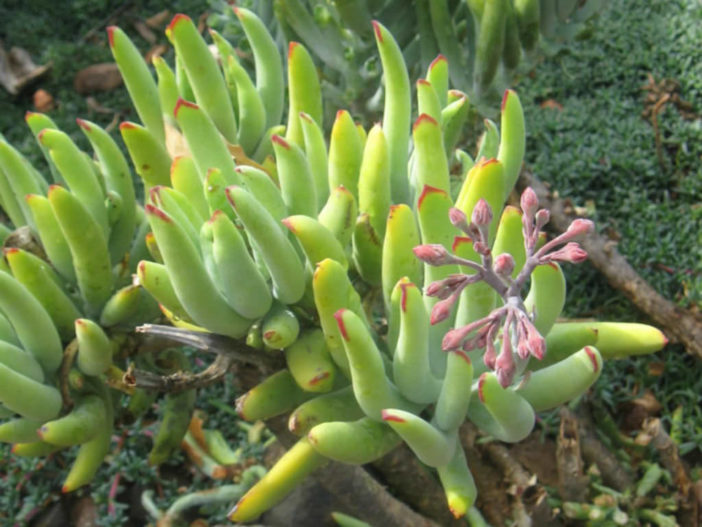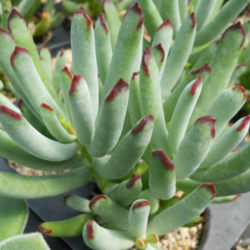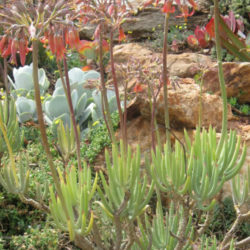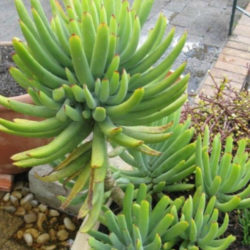Scientific Name
Cotyledon orbiculata var. flanaganii (Schönl. & Baker f.) Toelken
Synonym(s)
Cotyledon flanaganii, Cotyledon flanaganii subsp. flanaganii
Scientific Classification
Family: Crassulaceae
Subfamily: Kalanchoideae
Genus: Cotyledon
Description
Cotyledon orbiculata var. flanaganii, also known as Cotyledon flanaganii, is a sparsely branched succulent shrub with spreading branches and green to gray leaves arranged in whorls of 3. It can reach up to 3.3 feet (1 m) in height (including inflorescence). The branches are up to 0.4 inches (1 cm) in diameter, rigid, and somewhat woody with pale bark. The leaves are cylindrical, scarcely widened in the middle, tapering into a sharp point, measuring up to 3.6 inches (9 cm) long and 0.3 inches (0.8 cm) in diameter.
The flowers are red, often pinkish red due to a thick bloom, have a cylindrical tube up to 0.6 inches (1.5 cm) long, and narrowly oblong petals with a pointed tip. They appear in summer and droop from the top of the stalks that grow up to 9 inches (22.5 cm) tall.
Origin
Cotyledon orbiculata var. flanaganii is native to South Africa. It is restricted to the hills around the lower Kei River in the Eastern Cape province and grows on gravelly slopes in scrub vegetation.

Hardiness
USDA hardiness zones 9a to 11b: from 20 °F (−6.7 °C) to 50 °F (+10 °C).
How to Grow and Care
Cotyledons can be divided into two groups. One group consists of evergreen plants with a summer growing period. The other group is made up of deciduous plants, splendidly magnificent with large, solid, fleshy stems. The second group grows during the winter and sheds its leaves during the summer.
These succulents require a free-draining, gritty mix and plenty of sunlight. They tolerate cool, frost-free conditions during the winter if kept dry. Some require pruning to maintain an attractive shape. Cotyledons should be kept in a sunny position. Follow general succulent watering procedures. Be careful of overwatering when they are deciduous.
As succulents go, Cotyledons certainly are rewarding garden and indoor subjects, practically independent of irrigation in all but full desert conditions. However, they cannot survive poor light or bad drainage in the wet.
Feed it once or twice during the growing season with a fertilizer specifically formulated for cacti and succulents (poor in nitrogen), including all micronutrients and trace elements diluted to 1/2 the strength recommended on the label.
See more at How to Grow and Care for Cotyledon.
Links
- Back to genus Cotyledon
- Succupedia: Browse succulents by Scientific Name, Common Name, Genus, Family, USDA Hardiness Zone, Origin, or cacti by Genus
Photo Gallery
Click on a photo to see a larger version.


